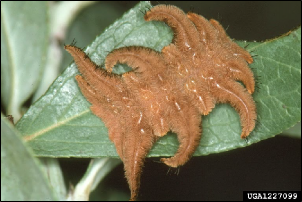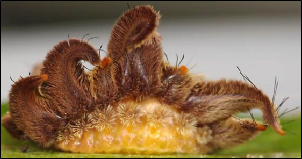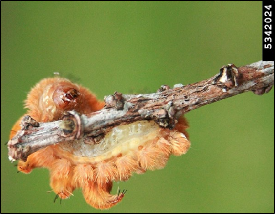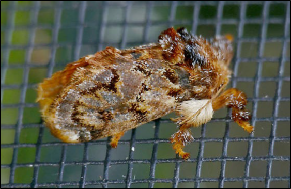Hag Moth Caterpillar
ID
ENTO-19NP (ENTO-541NP)
Introduction
The hag moth, Phobetron pithecium (Smith) (Lepidoptera: Limacodidae), is a native species found in shrubby fields and deciduous forests in the eastern half of the United States. Adult hag moths are rarely noticed, but the bizarre appearance of the caterpillars (Fig. 1) captures attention when seen. In addition, hag moth caterpillars have stinging hairs that produce skin irritations in some people.

Description
The peculiar appearance of the hag moth caterpillar makes it easy to recognize. The caterpillar has multiple pairs of fleshy appendages on its sides, some of which are long and twisted (Fig. 1). These appendages look somewhat like legs but are not used for movement; the caterpillar’s real legs are found underneath the body. The caterpillar can lose these appendages without real injury to its body, probably in self-defense to escape predators who are left holding an appendage but not the caterpillar itself.
The caterpillar is densely covered with short, brown hairs. The coloration is often light brown but can range from reddish to grayish brown. Under the appendages, tufts of short, stout hollow spines connect to toxin glands in the skin (Fig. 2). Contact with these spines produces a burning, itching sensation along with redness and inflammation similar to a bee sting.

Hidden underneath, the yellowish underside of the caterpillar is smooth and hairless (Fig. 3). The head capsule is brown and the legs are reduced in size. The caterpillars move in a smooth rolling or gliding motion rather than walking. They measure about 1 inch (2.5 cm) long when full grown.

Adult female moth moths are stout and furry. They range in color from tan to dark brown with irregular, wavy brown lines on the forewings (Fig. 4). There are large patches of white hairs on the middle pair of legs. Adult male hag moths are similar in size and coloration but have transparent patches on their wings.

Life History
The hag moth has a complete life cycle with egg, larval, pupal, and adult stages. The caterpillars are usually seen in late summer. There may be more than one generation a year in the southern United States.
Common Host Plants
The hag moth caterpillar is a generalist feeder and is commonly found on shade trees and ornamental shrubs. Rose, sassafras, alder, dogwoods, hickories, and spirea are preferred hosts. They also occur on oaks, ash, apple, and chestnut. Hag moth caterpillars feed on the surface of leaf tissue, but rarely cause major damage to their host plants.
Damage
Hag moth caterpillars are primarily a nuisance due to their stinging hairs. A person "stung" by a venomous caterpillar should immediately wash the affected area to remove any insect hairs and poison that remain. An ice pack will help reduce swelling, and creams and lotions containing steroids will lessen the discomfort and promote healing. People known to be sensitive to insect stings should consult a physician. The site of contact may remain painful and sore for several days.
Control
Hag moth caterpillars rarely occur in sufficient numbers to be considered plant pests, but people who work with ornamental plants or spend time in wooded areas should learn to recognize them and avoid touching them. Consider wearing a long- sleeved shirt, wide brimmed hat, and gloves if working with host plants in an area where hag moth caterpillars have been seen.
Interesting Facts
Some believe that the hag moth caterpillar mimics a spider as defense against predation by birds. Other species in the genus Phobetron are more tropical in their distribution, so the spider mimicry hypothesis may be more applicable in Central and South America where large, hairy spiders are found (Wagner 2005). Another common name for the hag moth caterpillar is monkey slug.
Note
For more information about venomous caterpillars in Virginia, see Virginia Cooperative Extension publication ENTO-75, Stinging Caterpillars: Slug Caterpillars and Flannel Moths.
Revised
Theresa A. Dellinger, January 3, 2023.
Reference
Wagner, David L. 2005. Caterpillars of Eastern North America: A Guide to Identification and Natural History. Princeton, NJ: Princeton Field Guides.
Virginia Cooperative Extension materials are available for public use, reprint, or citation without further permission, provided the use includes credit to the author and to Virginia Cooperative Extension, Virginia Tech, and Virginia State University.
Virginia Cooperative Extension is a partnership of Virginia Tech, Virginia State University, the U.S. Department of Agriculture (USDA), and local governments, and is an equal opportunity employer. For the full non-discrimination statement, please visit ext.vt.edu/accessibility.
Publication Date
January 10, 2023



